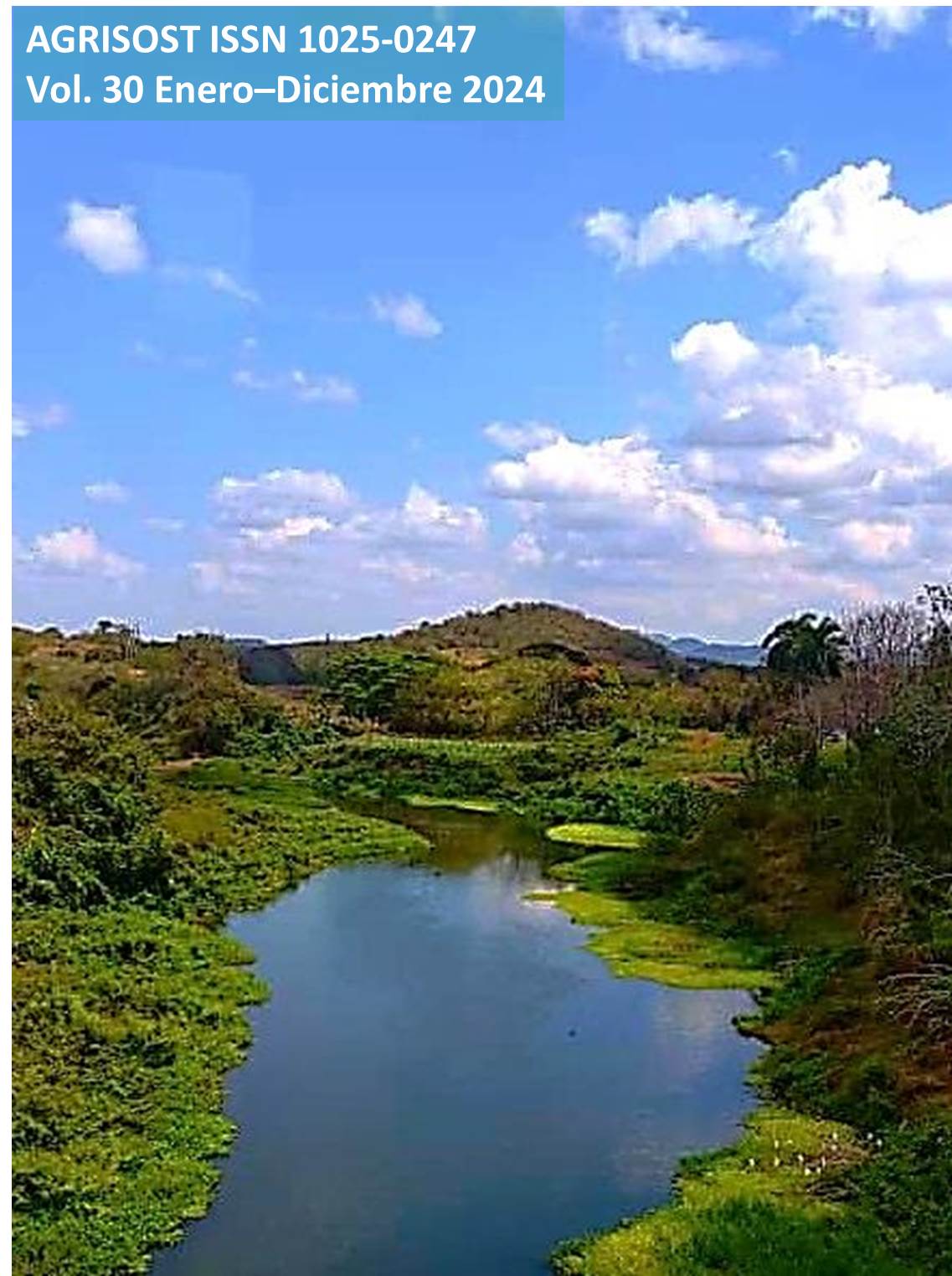Potential Growth Stimulant of Azotobacter Strains Isolated from Cuban Agroecosystems
DOI:
https://doi.org/10.5281/zenodo.15090167Palabras clave:
management, microorganisms, productsResumen
Context: The genus Azotobacter is used to stimulate the growth of economically important crops. Knowing the potential of native strains will allow for better use of the bacteria as active ingredients in bioproducts for Cuban agriculture.
Aim: To characterize three strains of Azotobacter isolated from Cuban agroecosystems as plant growth promoters.
Methods: The Azotobacter strains INIFAT-12, INIFAT-20, and INIFAT-21, conserved in the INIFAT Bacteria Collection, were characterized for their tolerance to abiotic stress conditions, nitrogen-fixing potential, nutrient solubilization, production of lytic enzymes, action against pathogenic fungi, and the effect of their application on beans, wheat, and tomatoes under controlled conditions.
Results: The growth of the three Azotobacter strains decreased under abiotic stress conditions, although a positive result was always observed, suggesting the presence of some tolerance mechanism. All strains fixed nitrogen and released protease and lipase enzymes; however, none of them solubilized nutrients or released cellulase enzymes. Only the INIFAT-20 strain produced amylase enzymes. Antagonistic activity was similar against Curvularia palense, while for Fusarium chlamydosporum, the INIFAT-20 strain stood out. The application of bacteria had a positive effect on the growth of bean, wheat, and tomato seedlings.
Conclusions: Azotobacter strains residing in Cuban agroecosystems have a potential as plant growth promoters, making this a promising genus for obtaining new agricultural bioproducts in Cuba.
Descargas
Referencias
Alcarraz, M., Gonzales, E., & Heredia, V. (2020). Azotobacter y Rhizobium como biofertilizantes naturales en semillas y plantas de frijol caupí. Avances, 22(2), 239-251. http://www.ciget.pinar.cu/ojs/index.php/publicaciones/article/view/538/1610.
Beleño-Carrillo, J., Gómez-Gómez, L., & Valero-Valero, N.O. (2022). Bacillus mycoides y ácidos húmicos como bioestimulantes de fríjol caupí bajo estrés por salinidad. Rev. U.D.C.A Act. & Div. Cient, 25(2), e1974. http://doi.org/10.31910/rudca.v25.n2.2022.1974
Bertini, E.V., Leguina, A. C. V., Castellanos, L. I., & Nieto, C.G. (2016). Caracterización de bacterias endofíticas de caña de azúcar productoras de N‐acil homoserina lactonas. Archivos de Bioquímica Química y Farmacia, 15(1), 5-19.
Blanco, E.L., & Castro, Y. (2021). Antagonismo de rizobacterias sobre hongos fitopatógenos, y su actividad microbiana en el potencial biofertilizante, bioestimulante y biocontrolador. Revista Colombiana de Biotecnología, 23 (1), 6-16. https://doi.org/10.15446/rev.colomb.biote.v23n1.84808
Cesa-Luna C, Baez A, Quintero-Hernández V, Cruz-Enríquez J. D. L, Castañeda-Antonio M. D., & Muñoz-Rojas, J. (2020). The importance of antimicrobial compounds produced by beneficial bacteria on the biocontrol of phytopathogens. Acta Biológica Colombiana, 25 (1), 140-154. https://doi.org/10.15446/abc.v25n1.76867
Chávez-Díaz, I.F., Zelaya, L.X., Cruz, C.I., Rojas, E., Ruíz, S., & de los Santos, S. (2020). Consideraciones sobre el uso de biofertilizantes como alternativa agro-biotecnológica sostenible para la seguridad alimentaria en México. Revista Mexicana Ciencias Agrícolas, 11 (6), 1423-1436. https://doi.org/10.29312/remexca.V9i4.1389
Cruz Cárdenas, C.I., Zelaya-Molina, L. X., Chávez-Díaz. I.F., Rojas-Anaya, E., & Arteaga-Garibay, R.I. (2021). Conservación de cepas microbianas para biofertilizantes. Libro teórico. (No. 02). Centro Nacional de Recursos Genéticos. Tepatitlán de Morelos. Jal. México.
Dirección de Suelos y Fertilizantes (2021). Listado Oficial de Fertilizantes Autorizados. Registro Central de Fertilizantes.
Harrigan, W.F., & M. Mc. Cance. (1968). Métodos de Laboratorio de Microbiología. Ed. Academia, España.
Huamán-Castilla, N. L., Allcca-Alca, E. E., Allcca-Alca, G. J., & Quispe-Pérez, M. L. (2021). Biopolímeros producidos por Azotobacter: síntesis y producción, propiedades físico-mecánicas, y potenciales aplicaciones industriales. Scientia Agropecuaria, 12(3), 369-377. https://dx.doi.org/10.17268/sci.agropecu.2021.040
Ibarra, J.A., Llica, W.R., & Lazo, R.S. (2021). Determinación de la influencia de Azotobacter nativos en cultivos de Raphanus sativus como biofertilizante. Ingeniería investiga, 3(1), 579-590. https://doi.org/10.47796/ing.v3i1.482
Martínez, R. & Dibut, B. (2012). Biofertilizantes Bacterianos. Editorial Científico-Técnica. Instituto Cubano del Libro.
Martínez, V. R., López, M., Brossard, F. M., Tejeda, G. G., Pereira, A. H., Parra, Z. C., Rodríguez, S. J., & Alba, A. (2006). Procedimientos para el estudio y fabricación de Biofertilizantes Bacterianos. (Serie B, No. 11). Ed. INIA - Maracay.
Nautiyal, S. C. (1999). An efficient microbiological growth medium for screening phosphate solubilizing microorganism. FEMS Microbiology Letters, 170, 265-275.
Ortiz, Y., Ríos, Y., Aguado, Y., Rodríguez, L.C., Lorenzo, Y., Deliz, L., Álvarez, M.E., Rodríguez, J., Zulueta, I., & Fresneda, J.A. (2021). Selección de cepas bacterianas con potencial estimulador del crecimiento vegetal en Phaseolus vulgaris L. (cv. 'Lewa'). Agrotecnia de Cuba, 45(1), 42 – 58.
Pavone, D. (2022). Azotobacter en la agricultura: Una bacteria biofertilizante que protege a las plantas. TecnoVita. https://tecnovitaca.com/wp-content/uploads/2022/12/Azotobacter.pdf
Pérez-Cordero, A., Tuberquia-Sierra, A., & Amell-Jiménez, D. (2014). Actividad in vitro de bacterias endófitas fijadores de nitrógeno y solubilizadores de fosfato. Agronomía Mesoamericana, 25(2), 213-223. https://www.scielo.sa.cr/pdf/am/v25n2/a01v25n2.pdf
Pilatuña, M.F., González, M.M., Mero, M.E. & Risco, D. (2021). Evaluación agronómica de bacterias fijadoras de nitrógeno aisladas de suelos andinos en plántulas de lechuga y tomate. Investig. Agrar, 23(1), 47-52. http://dx.doi.org/10.18004/investig.agrar.2021.junio.2301680.
Sánchez-Yánez, J. M., Velázquez-Medina, A., Cabrera-Reinaldo, I., Amador-Vargas, W.L.., & Vela-Muzquiz, G. R. (2022). Supervivencia de Azotobacter y otros grupos microbianos en suelo seco almacenado. Journal of the Selva Andina Research Society, 13(1), 3-15. https://doi.org/10.36610/j.jsars.2022.130100003
Sule, I.O., Agbabiaka, T.O., Saliu B.K., Ajijolakewu K.A., & Zakariyah R.F. (2023). Assessment of the potentials of Azotobacter spp. as bioinoculants on the growth of potted maize plants. Science World Journal, 18(2), 276-282. https://dx.doi.org/10.4314/swj.v18i2.16.
Sumbul, A., Ali Ansari, R., Rizvi, R., & Mahmood, I. (2020). Azotobacter: A potential bio-fertilizer for soil and plant health management. Saudi Journal of Biological Sciences, 27, 3634-3640. https://doi.org/10.1016/j.sjbs.2020.08.004
Vera Loor, M., Bernal, A., Vera, D., Leiva, M., Rivero, A., & Agustín, A. (2020). Antagonismo in vitro de bacterias endófitas formadoras de endosporas frente a Moniliophthora roreri H.C Evans. Revista de Protección Vegetal, 35(2), 8.
Zavala, J., Alcarraz, M., & Julian, J. (2020). Evaluación para la producción de Azotobacter sp. promotor de crecimiento para cultivos de Coffea arabica. Ciencia e Investigación, 23(1), 45-50. http://dx.doi.org/10.15381/ci.v23i1.18751
Descargas
Publicado
Número
Sección
Licencia

Esta obra está bajo una licencia internacional Creative Commons Atribución-NoComercial-SinDerivadas 4.0.
Usted es libre de:
- Compartir — copiar y redistribuir el material en cualquier medio o formato
- La licenciante no puede revocar estas libertades en tanto usted siga los términos de la licencia
Bajo los siguientes términos:
- Atribución — Usted debe dar crédito de manera adecuada , brindar un enlace a la licencia, e indicar si se han realizado cambios . Puede hacerlo en cualquier forma razonable, pero no de forma tal que sugiera que usted o su uso tienen el apoyo de la licenciante.
- NoComercial — Usted no puede hacer uso del material con propósitos comerciales .
- SinDerivadas — Si remezcla, transforma o crea a partir del material, no podrá distribuir el material modificado.







